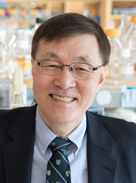 |
김광수(McLean Hospital, Harvard Medical School)
Parkinson’s disease (PD) is a neurodegenerative disorder associated with age-dependent loss of midbrain dopamine (mDA) neurons in the substantia nigra. Based on his 30 years’ investigation of the transcriptional cascade of mDA neurons, Prof. Kim’s lab is focusing his efforts on translational research to develop novel therapeutic avenues for PD. First, he identified the orphan nuclear receptor Nurr1 as a promising drug target for mechanism-based neuroprotective therapeutics. Although Nurr1 was viewed as a ligand-independent, constitutively active transcription factor, Prof. Kim identified both synthetic and native ligands that directly bind to Nurr1 to robustly activate its transcriptional functions as both activator and repressor. Using both in vitro and in vivo studies, Prof. Kim showed that these ligands can prominently ameliorate motor defects in rodent models of PD in a neuroprotective manner without dyskinesia-like side effects, rendering them to be promising drug candidates. Second, the unique loss of mDA neurons observed in PD makes it a promising disease for cell replacement therapy. As a first step towards personalized cell therapy for PD, Prof. Kim established a platform of core techniques to successfully treat a PD patient using his own skin cell-derived dopamine cells. In this lecture, Prof. Kim will discuss how basic molecular studies can be translated into novel therapeutic approaches for PD, demonstrating a proof-of-principle of “bench to bed side” approach.
Representative papers
- Kim J, Jeon J, Song B, Lee N, Ko S, Cha Y, Leblanc P, Seo H, and Kim KS (2021) Spotting-based differentiation of functional dopaminergic progenitors from human pluripotent stem cells. Nat. Protocol, In press.
- Schweitzer JS, Song B, and Kim KS (2021) A step closer to autologous cell therapy for Parkinson’s disease. Cell Stem Cell, 18(3):321-328. PMID: 31214702
- Song B, Cha Y, Ko S, Jeon J, Lee N, Seo H, Park K-J, Feitosa M, Luna M, Jung J-H, Kim J, Lee I-H, Hwang D, Cohen B, Teicher M, Leblanc P, Carter B, Kordower JH, Bolshakov VY, Kong SW, Schweitzer J, and Kim KS (2020) Human autologous iPSC-derived dopaminergic progenitors restore motor function in Parkinson’s disease models. J. Clin. Invest. 130(2):904-920. PMID: 31714896. (featured in Commentary, J. Clin. Invest. (2020) 130: 601-603, Jun Takahashi. PMID:31929191).
- Schweitzer JS, Song B, Herrington TM, Park T-Y, Lee N, Ko S, Jeon J, Cha Y, Kim K, Li Q, Henchcliffe C, Kaplitt M, Neff C, Rapalino O, Seo H, Lee I-H, Kim J, Kim T, Petsko GA, Ritz J, Cohen BM, Kong SW, Leblanc P, Carter BS, and Kim KS (2020) Personalized iPSC-derived Dopamine Progenitor Cells for Parkinson’s Disease. N Eng J Med. 382(20):1926-1932. doi: 10.1056/NEJMoa1915872. PMID: 32402162. (featured by Malin Parmar and Anders Bjorklund Anders, Cell Stem Cell (2020) 27:8-10; featured by Hannah Stower in Research Highlight, Nat. Medicine (2020) 26:822).
- Rajan S, Jang Y, Kim CH, Toh HT, Jeon J, Song B, Maqueda AS, Lescar J, Yoo JY, Beldar S, Liu X-W, Feitosa M, Hwang D, Goh G, Lim K-L, Park HM, Lee CH, Oh SF, Petsko GA, Yoon HS, Kim KS (2020) PGE1 and PGA1 bind to Nurr1 (NR4A2) and activate its transcriptional function. Nat. Chem. Biol., 16(8):876-886. PMID: 32451509
- Cha, Y., Han, M.-J., Cha, H.-J., Zoldan, J., Burkart, A., Jung, J.H., Jang, Y., Kim, C.-H., Jeong, H.-C., Kim, B.-G., Langer, R., Kahn, C.R., Guarente, L., and Kim, K.S. (2017) Metabolic control of primed human pluripotent stem cell fate and function by the miR-200c-SIRT2 axis. Nature Cell Biology, 19(5):445-456. PMID: 28436968 (featured in News and Views, Nature Cell Biology 19(5): 412-414)
- Kim, K.S. (2017) Toward neuroprotective treatments of Parkinson’s disease. P.N.A.S. 11;114(15):3795-3797. PMID: 28360200
|

